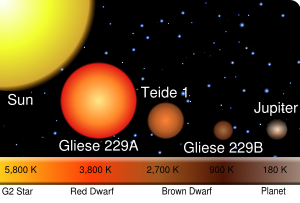
Jupiter mass
Encyclopedia

Mass
Mass can be defined as a quantitive measure of the resistance an object has to change in its velocity.In physics, mass commonly refers to any of the following three properties of matter, which have been shown experimentally to be equivalent:...
equal to the total mass of the planet Jupiter
Jupiter
Jupiter is the fifth planet from the Sun and the largest planet within the Solar System. It is a gas giant with mass one-thousandth that of the Sun but is two and a half times the mass of all the other planets in our Solar System combined. Jupiter is classified as a gas giant along with Saturn,...
' onMouseout='HidePop("84696")' href="/topics/Earth_mass">Earth mass
Earth mass
Earth mass is the unit of mass equal to that of the Earth. 1 M⊕ = 5.9722 × 1024 kg. Earth mass is often used to describe masses of rocky terrestrial planets....
; 1 Earth mass equals 0.00315 Jupiter masses). Jupiter mass is used to describe masses of the gas giant
Gas giant
A gas giant is a large planet that is not primarily composed of rock or other solid matter. There are four gas giants in the Solar System: Jupiter, Saturn, Uranus, and Neptune...
s, such as the outer planets and extrasolar planet
Extrasolar planet
An extrasolar planet, or exoplanet, is a planet outside the Solar System. A total of such planets have been identified as of . It is now known that a substantial fraction of stars have planets, including perhaps half of all Sun-like stars...
s. It is also used in describing brown dwarfs.
The most massive exoplanets are typically described in terms of Jupiter masses as this provides a convenient scale for comparison. A Jupiter-mass planet at an orbital distance of 1 AU from a Sun
Sun
The Sun is the star at the center of the Solar System. It is almost perfectly spherical and consists of hot plasma interwoven with magnetic fields...
-like star
Star
A star is a massive, luminous sphere of plasma held together by gravity. At the end of its lifetime, a star can also contain a proportion of degenerate matter. The nearest star to Earth is the Sun, which is the source of most of the energy on Earth...
causes an amplitude shift of 28 m/s, which is detectable with current technology. The most readily detectable planets through radial velocity measurements have high mass and close orbits. This produces a selection effect
Selection bias
Selection bias is a statistical bias in which there is an error in choosing the individuals or groups to take part in a scientific study. It is sometimes referred to as the selection effect. The term "selection bias" most often refers to the distortion of a statistical analysis, resulting from the...
for planets of Jupiter mass. Likewise, Jupiter mass or higher planets are more likely to be detected through other means, such as transits or microlensing.
A planet with a Jupiter mass might not have the same dimensions.
The theoretical minimum mass a star can have, and still undergo hydrogen
Hydrogen
Hydrogen is the chemical element with atomic number 1. It is represented by the symbol H. With an average atomic weight of , hydrogen is the lightest and most abundant chemical element, constituting roughly 75% of the Universe's chemical elemental mass. Stars in the main sequence are mainly...
fusion at the core, is estimated to be about 75 times the mass of Jupiter, though fusion of deuterium
Deuterium burning
Deuterium burning is a nuclear fusion reaction that occurs in stars and some substellar objects, in which a deuterium nucleus and a proton combine to form a helium-3 nucleus...
can occur at masses as low as 13 Jupiters.
In the solar system
Solar System
The Solar System consists of the Sun and the astronomical objects gravitationally bound in orbit around it, all of which formed from the collapse of a giant molecular cloud approximately 4.6 billion years ago. The vast majority of the system's mass is in the Sun...
, the masses of the outer planets can be listed in Jupiter mass.
- JupiterJupiterJupiter is the fifth planet from the Sun and the largest planet within the Solar System. It is a gas giant with mass one-thousandth that of the Sun but is two and a half times the mass of all the other planets in our Solar System combined. Jupiter is classified as a gas giant along with Saturn,...
– 1.000 - SaturnSaturnSaturn is the sixth planet from the Sun and the second largest planet in the Solar System, after Jupiter. Saturn is named after the Roman god Saturn, equated to the Greek Cronus , the Babylonian Ninurta and the Hindu Shani. Saturn's astronomical symbol represents the Roman god's sickle.Saturn,...
– 0.299 - UranusUranusUranus is the seventh planet from the Sun. It has the third-largest planetary radius and fourth-largest planetary mass in the Solar System. It is named after the ancient Greek deity of the sky Uranus , the father of Cronus and grandfather of Zeus...
– 0.046 - NeptuneNeptuneNeptune is the eighth and farthest planet from the Sun in the Solar System. Named for the Roman god of the sea, it is the fourth-largest planet by diameter and the third largest by mass. Neptune is 17 times the mass of Earth and is slightly more massive than its near-twin Uranus, which is 15 times...
– 0.054
One Jupiter mass can be converted to related units:
- 25,839 Lunar mass (ML)
- 317.83 Earth massEarth massEarth mass is the unit of mass equal to that of the Earth. 1 M⊕ = 5.9722 × 1024 kg. Earth mass is often used to describe masses of rocky terrestrial planets....
(M⊕) - 0.0009546 Solar massSolar massThe solar mass , , is a standard unit of mass in astronomy, used to indicate the masses of other stars and galaxies...
(Ms)

